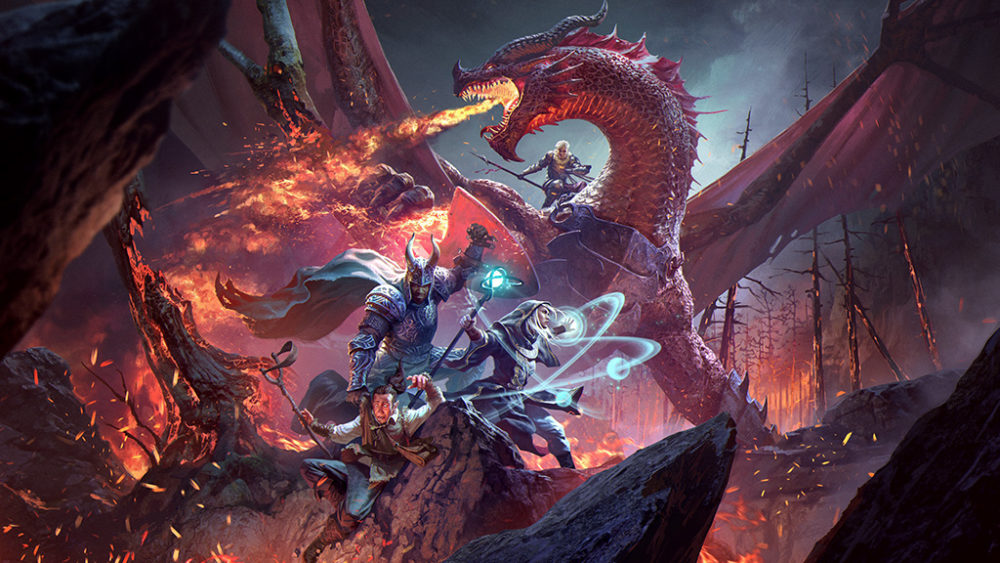
Roll initiative, find your lance, and keep your kender close — Dragonlance is coming to 5e.
We can finally revisit an old favorite setting (with new mechanics!) as Dragonlance: Shadow of the Dragon Queen brings the world of Krynn to 5th edition Dungeons & Dragons. The new module will show players parts of Krynn they’ve never seen before. Wizards of the Coast is also releasing the Warriors of Krynn board game with Shadow of the Dragon Queen on Dec. 6, which can integrate into the module, as well as function as a standalone strategy game.
Dragonlance is a classic and incredibly popular rich fantasy setting, one well-known to many a long-time Dungeons & Dragons player. It was released before the ever-prominent Forgotten Realms, and represents one of the early D&D settings for players to explore. The Dragonlance setting had its first adventuring module published in 1984 with TSR Inc., the company that published D&D prior to Wizards of the Coast. Though it started in AD&D (1st edition), it’s now coming to modern players with a 5th edition release.
What can fans of tabletop roleplay expect from the new take on a timeless setting? We have the inside info for any discerning adventurer, thanks to a press briefing from Greg Tito, host of the official D&D podcast Dragon Talk; Wes Schneider, lead designer of Shadow of the Dragon Queen; and Rob Daviau, one of two lead designers for the Warriors of Krynn board game. Here are five things we now know about these new releases.
1. You can get the Shadow of the Dragon Queen physical book with the D&D Beyond digital version.
Alright, so this isn’t the nitty-gritty of the story, but this is substantial news for anyone who uses D&D Beyond for their campaigns. D&D Beyond is Wizards of the Coast’s online toolkit for 5th edition D&D. Players and dungeon masters (DMs) can use it to make character sheets, roll dice, and view things like spell lists.
Historically, the digital books on D&D Beyond and the physical books in game stores were entirely separate products. If you owned a copy of Volo’s Guide to Monsters, you’d still need to buy it digitally as well if you ran a campaign on D&D Beyond and had a player who wanted to play a bugbear, for example.
But now, for the first time, the digital version is bundled with the physical copy. You won’t need to purchase the Shadow of the Dragon Queen book twice, which is great news for D&D fans who like having the physical book as well as the ability to use the online toolset.
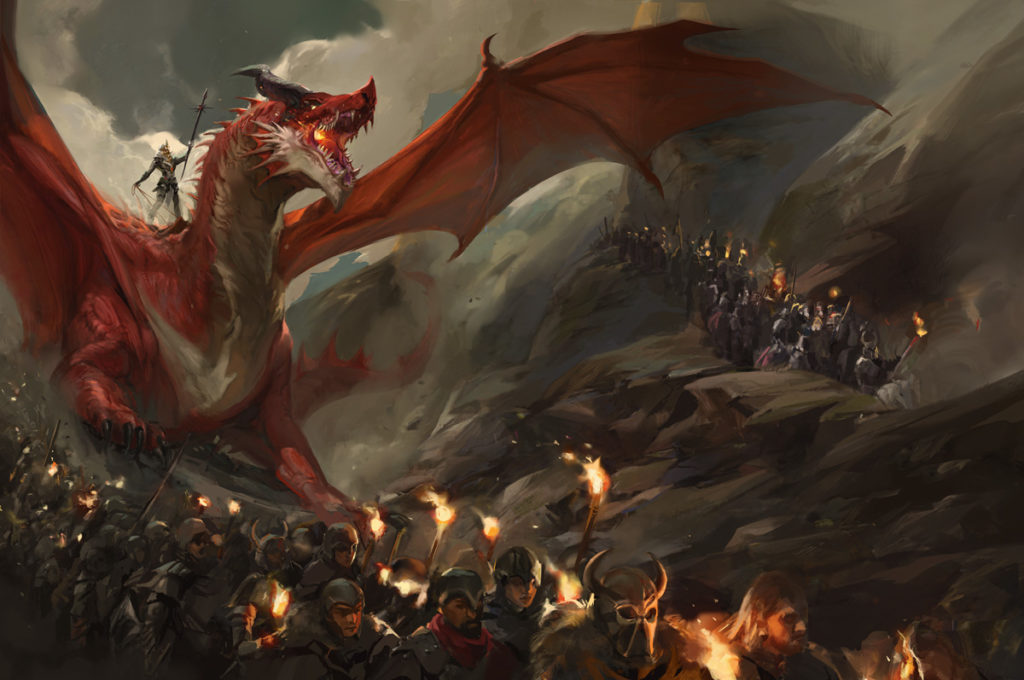
But what matters most is, of course, the book’s content. There’s plenty to be said about that, including what you do before you start playing — making your character. And who can that character be? There’s one option that’s likely to create some opinions.
2. They’re bringing back playable Kender.
The ever-mischievous, somewhat controversial, and near-fearless Kender are making their return to the world of D&D as a playable race option. Depending on who you are, you may think Kender are either lovably curious… or difficult little kleptomaniacs. Some DMs have banned them from their campaigns, put limits on their use, or simply embraced whatever chaos a Kender player opts to bring to the table.
Kender were first introduced in the Dragonlance novels but soon made their way to being both characters and a player race option in the tabletop modules. They’re human-like people who are particularly small in stature, different from but often compared to The Lord of the Rings‘ hobbits.
They are frequently described as childlike — they’re curious to a fault, lack fear, and have a tendency to “borrow” items from others for extended periods, earning them a reputation as thieves. They don’t have much in the way of organized society, as individual Kender tend to wander.
These traits can occasionally cause friction with some players or DMs, as things can derail quickly if someone opts to have their Kender constantly stealing from non-player characters (NPCs) or running headfirst into danger when the party would rather wait. It’s still a perfectly valid take, however, that a Kender who is played well (and with some care given to the other party members), can make for an interesting and fun addition to a group.
The Kender also won’t be the only option to play as in Shadow of the Dragon Queen, though Wes Schneider calls them “one of the most noteworthy peoples in the campaign setting.” There’s plenty more playable races to choose from, including elves, dwarves, and others that exist within Dragonlance. We’re also getting a new subclass themed around Dragonlance with the Lunar Sorceror. And once you’ve made your character, you’ll get into the actual meat of the setting, which starts surprisingly small for such an expansive world.
3. Shadow of the Dragon Queen puts players in a part of Krynn we’ve never seen before.
Krynn is a well-trodden setting, but that doesn’t mean there aren’t new pockets to explore. Shadow of the Dragon Queen is starting refreshingly small, putting players in the charming little fishing village of Vogler. It’s located in eastern Solamnia, a nation of humans ruled by an emperor. The module starts player characters at level 1, so it’s only natural to begin with something more small and intimate.
After a series of three short prelude encounters that introduce players to the setting and its happenings, the party finds themselves meeting in Vogler. Vogler has a cast of characters for players to fall in love with and (spoilers!) to protect once things start to get messy with initial rumors of the first Dragon Army forces coming in from the east. The module will definitely do its best to invest you in the town before any sort of disaster strikes, which will bring on the emotional stakes.
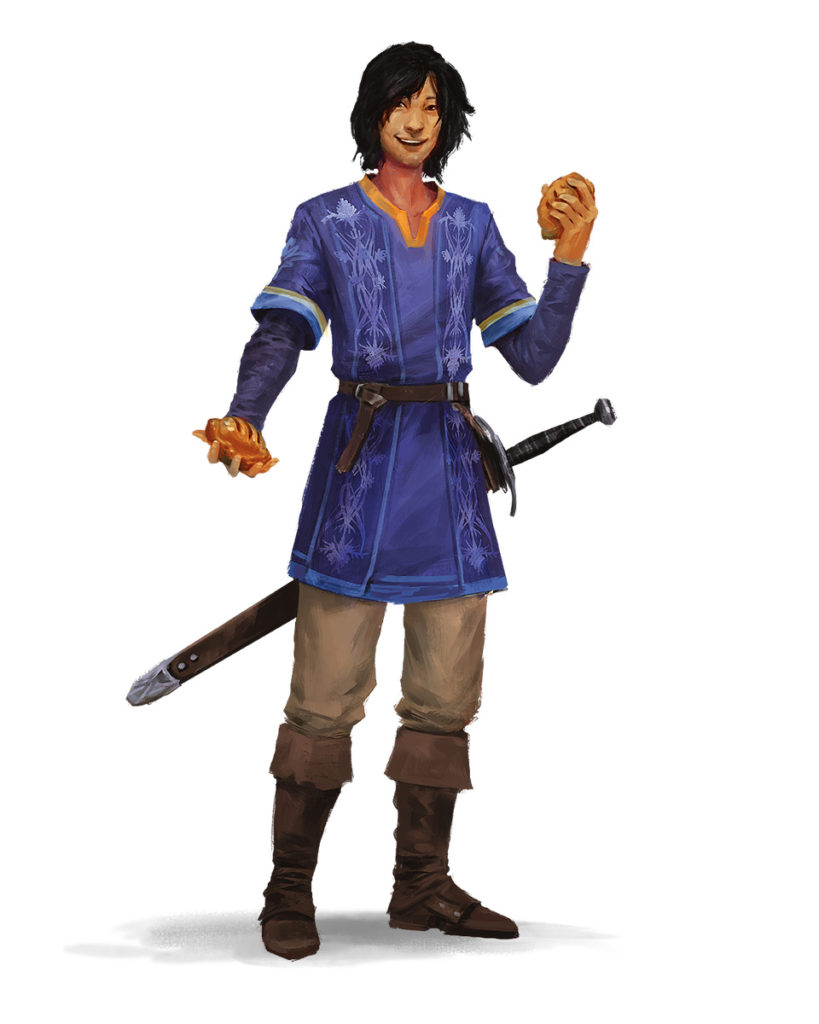
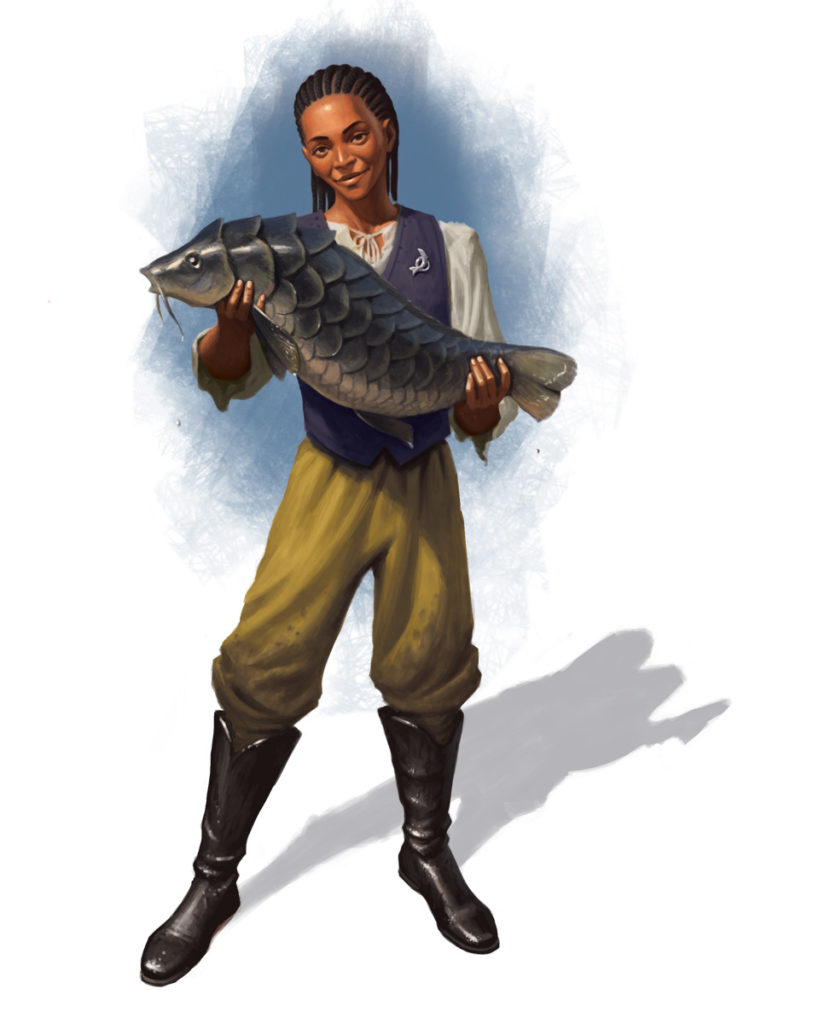
Darrett Highwater, one of the first NPCs you meet as a player in Shadow of the Dragon Queen, is a resident of Vogler and a squire working under a knight. The art for Raven, the mayor of Vogler, depicts her holding a large fish catch, which makes sense considering the village’s status as a fishing town. Speaking of, players end up in Vogler during the Kingfisher Festival, which Wes Schneider describes as “a celebration of the town and of their fishing community and lifestyle.”
During the Kingfisher Festival, the module will include plenty of activities at the celebration, so players can stretch their legs before things get serious. You can play carnival mini-games as well as go head-to-head with Raven — who is one of the best anglers in town — in a fishing competition.
But the revelry can’t last forever, thanks to the aforementioned trouble brewing to the east. Rumors of strange, dragonlike people and mercenaries on the scene all culminate in a large battle, which players will find themselves in the midst of. If you pick up the Warriors of Krynn board game with your Shadow of the Dragon Queen purchase, you’ll have a new way to handle this combat.
4. Warriors of Krynn gives DMs a fresh way to run huge combats.
The Warriors of Krynn board game and the Shadow of the Dragon Queen module are both functional as standalone experiences. However, they can integrate with one another to give players and DMs a toolkit for running large combats that happen within the campaign.
Rob Daviau, one of two lead designers of Warriors of Krynn along with Stephen Baker, joined the press meeting to talk about the board game in detail. Rob explained the overall design philosophy of Warriors of Krynn, saying, “D&D battle is really at the one-on-one level, or a party versus a little tiny squad, but what happens when you’re on a battlefield and there’s hundreds or thousands of people fighting all around you?”
The initial battle starts within Vogler, as the Dragon Army makes an actual appearance. This being a small fishing village, regular citizens need to be evacuated. And the party finds itself in the middle of this. If you get the board game, then Warriors of Krynn will have players taking their characters into the fight mechanically, with each player character represented by a mini (minis are included in the game, though if you have one for your character, you can use that as well).
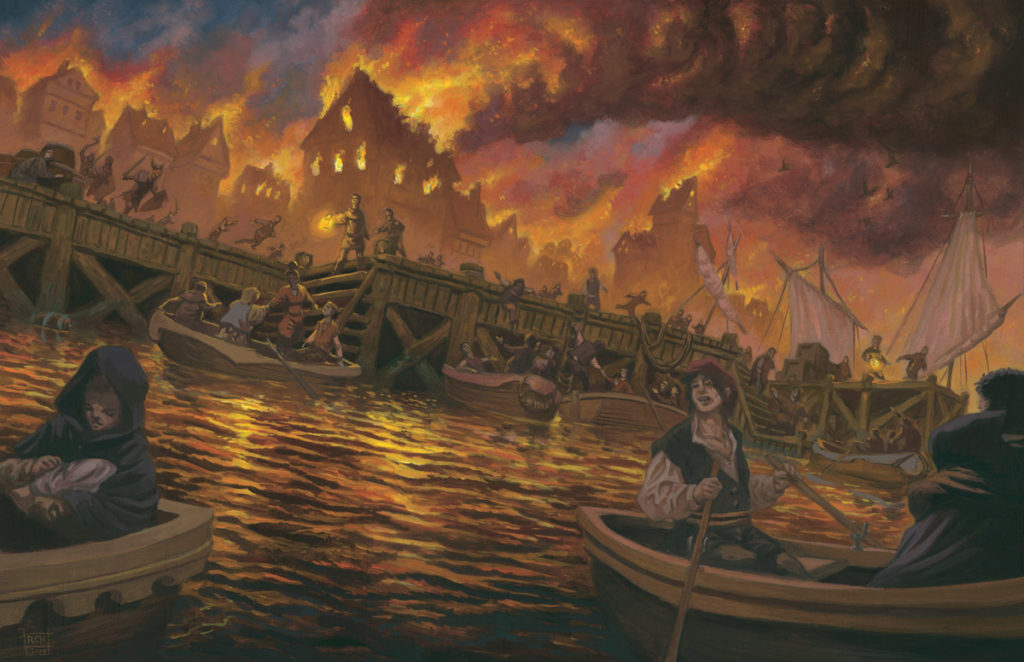
The game uses custom six-sided dice, a departure from the traditional 20-sided D&D die. “Yeah, that was a little scary pitching to Wizards,” Daviau says. “Like, hey you know what, I’m going to take the 20-sider out — how’s that going to work with everyone?” The change will hopefully be refreshing for players who would like to see some new mechanical experiences. Players will definitely have this, as Rob went into detail on what running a scenario in Warriors of Krynn might look like.
5. The game puts you not in the role of commanders, but in the role of adventurers in the middle of a larger battle.
There are 12 battle scenarios within the Warriors of Krynn board game, with varying terrain, events, and setups. There are four designed for lower levels, four for mid-levels, and four for higher levels. So, as your characters make level progress in the module, they also make progress in the board game.
The setup of the board features both a left and a right flank of the larger battle. The game uses shaped tokens to represent different units. The little bowtie shapes are foot units, the middle arrow shapes are missile units, and the back units (shaped like long hexagons) are mounted units. Purple units are a part of the alliance, and red units are a part of the Dragon Armies. The setup of these units is determined by the scenario described in the booklet, not by the players acting as some sort of commander. It’s not an entirely traditional wargame, because the battle is quite literally bigger than your character’s ability to influence it entirely. You are a piece of the battlefield.
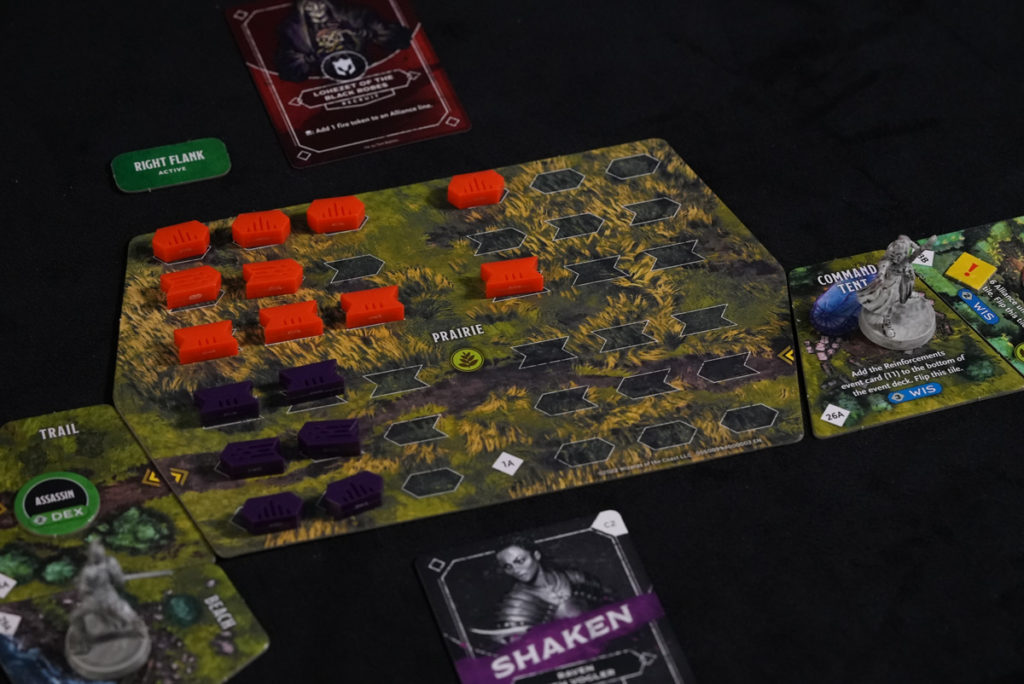
Players will take a hero card based on the class they play, and are tasked with doing special missions within the scenario. (If you are playing the game as a standalone, players choose the class they wish to play.) Say the village of Vogler is being attacked, maybe your job is to help escort people out to minimize civilian casualties.
Every player gets around five to eight turns to make things happen, with four actions per turn. At the start of every player’s turn, that player flips over a card in the event deck and something happens, often something bad. After the event resolves, players can use their actions, such as calling for reinforcements, helping shaken commanders, or raiding a tomb for a useful item. Some actions will be better if you have expertise in the skill — calling for reinforcements, for example, costs three actions, but only two if your character is good at Wisdom. You can also move your mini across roads to access different tiles within the game, navigating through the battlefield.
There are commander cards on each side, for both the Alliance and the Dragon Armies. These commanders are often NPCs that players will meet within Shadow of the Dragon Queen. For example, the first scenario features Raven the mayor of Vogler as a commanding officer within the board game, as well as Darrett the squire as a unit. This is one of the ways that Warriors of Krynn manages to create stakes and narrative investment — the units on your side are people you’ve talked to, and the villains very possibly are people that have taunted you previously.
Commanders and units can be shaken or ready, and players can opt to spend some actions readying them. A commander that is shaken is less prepared and has less options, while readied means they are steadier emotionally. Mechanically, a shaken commander essentially has one hit point, while a readied commander has two, with hit points being represented by stress. If characters take enough stress from events or the actions of other units, they are removed from the battlefield.
Now you might be worried about how much influence you have when you’re not commanding all of the action. However, if the characters just sit in the command tent and do nothing for the full game, it won’t take very long for things to start going poorly. Though you don’t control the full battlefield, you do clearly influence what’s happening.
No D&D experience would be complete without letting an element of chance into things, which this game also has. The custom six-sided dice influence things in a very real way. There’s a blank side, a side representing one hit, a side representing two hits, and a side for “woe” which means something bad happens to the roller. Players can directly target the enemy commanders, called vile champions, in an attempt to hit them, giving enough stress to remove them, though this is not without risk.
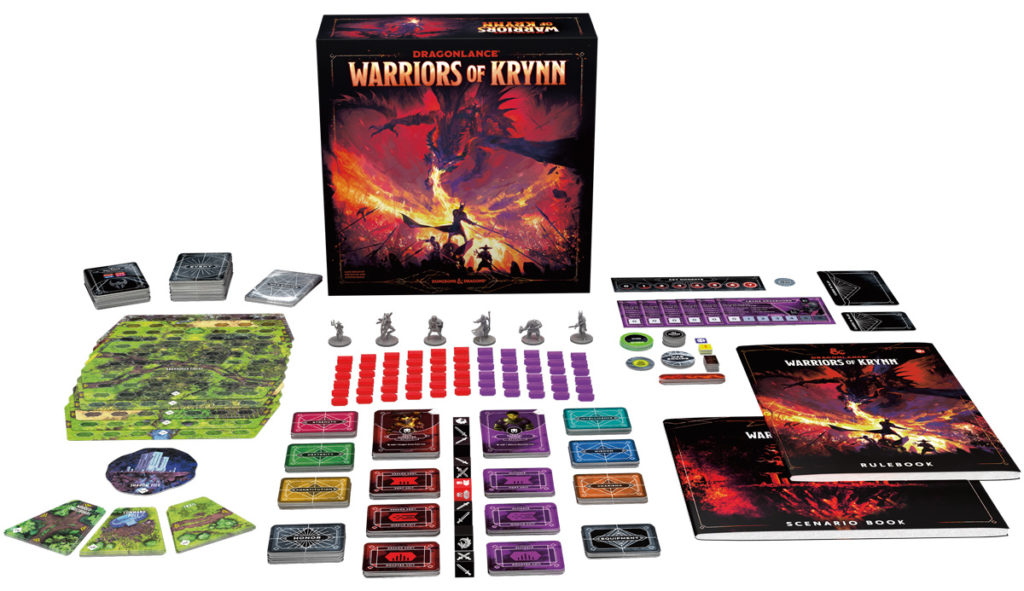
The forever DMs reading this might be wondering what the DM is supposed to be doing during all this if you’re using the board game as a companion to Shadow of the Dragon Queen. You have a few options. The board game is designed for three to five players, so if you have less than five players as a DM, you can take one of the character cards and play along cooperatively, influencing things along with your players. If you have more than five players, you can do what the DM normally does in D&D as your players play through it. You can read the text on event cards, roll dice for the enemies, and add voice lines from NPCs to make things more narratively satisfying. Say Lohezet of the Black Robes sets fire to a tile — the DM can add a bit of roleplay taunting to the experience to keep everyone engaged.
Some of the battle scenarios are very much made for key moments within the module, while others are a little more flexible about placement. Naturally, many DMs will see this news and wonder if they can use the Warriors of Krynn board game within their own homebrew setting to make larger battles more interactive. This will take a bit of customization work, but a DM interested in incorporating Warriors of Krynn mechanics should be able to use the board game in their own campaign setting.
Get ready to experience Krynn like never before.
The introduction of Dragonlance to 5th edition is rolling a natural 20 with intriguing mechanical additions and a part of Krynn players haven’t seen, putting them right at the beginning of the War of the Lance.
The Shadow of the Dragon Queen book physical plus digital bundle is available for preorder now for $59.94 and is releasing on Dec. 6, with early access to the digital content on D&D beyond starting on Nov. 22. The bundle that includes everything above plus the Warriors of Krynn board game is available for $154.98 with the same release schedule.
And if this release sees popularity, there’s potentially more where that came from. Wes Schneider expressed a real interest in audience feedback after the release. The Warriors of Krynn board game doesn’t feature a digital component, but there was some hinting at the possibility for future endeavors, as well as the use of similar war games for other campaign settings. So start your backstory brainstorming now and get ready to experience the War of the Lance in 5th edition!
